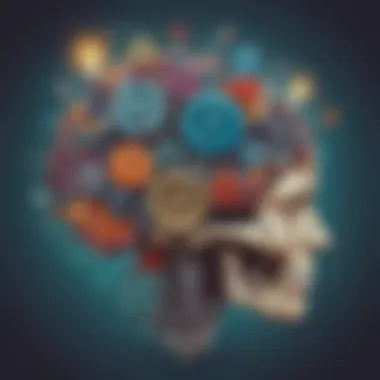Exploring Pi Day: Engaging Lessons for Young Science Enthusiasts


Science Fun Facts
As we embark on our scientific exploration for Pi Day, let's start by uncovering some fascinating fun facts about this irrational yet intriguing number. Did you know that Pi is an infinite decimal, meaning it goes on forever without repeating? This mathematical constant is crucial in calculating the circumference of a circle, making it a cornerstone in geometry. Young science enthusiasts can engage with Pi by exploring its digits and even participating in the annual Pi Day memorization competitions held worldwide, showcasing the awe-inspiring capabilities of the human mind.
Discover the Wonders of Science
Moving beyond mere numbers, let's delve into the enchanting world of science where imagination meets reality. From understanding the concept of gravity and the laws of motion to witnessing the beauty of chemical reactions through colorful experiments, science opens up a realm of endless possibilities. Educational videos and animations serve as windows into complex scientific principles, breaking them down into digestible bits for our budding scientists to grasp. Real-life applications of science, from the simple act of boiling water to the intricate workings of a computer, surround us, offering a never-ending source of wonder and discovery.
Science Quiz Time
Now, it's time to put our knowledge to the test with an array of interactive quizzes designed to challenge and enlighten our inquisitive minds. Multiple-choice questions tap into various scientific domains, from biology to astronomy, encouraging children to think critically and expand their understanding of the world around them. Brain teasers and puzzles inject an element of fun into learning, fostering problem-solving skills and creative thinking. By gamifying the learning process, these quizzes become not only educational but also entertaining, transforming dry facts into exciting mental adventures.
Science Experiment Showcase
Prepare your lab coats and safety goggles as we delve into the heart of scientific exploration - hands-on experiments. These fun and engaging activities allow young scientists to witness principles in action, from the laws of physics to the reactions between different substances. Clear, step-by-step instructions guide them through each experiment, ensuring safety and understanding at every stage. A detailed materials list makes it easy to gather everything needed, while crucial safety tips and precautions ensure a secure and enjoyable scientific journey ahead.
Introduction to Pi Day
In the realm of mathematical celebrations, Pi Day stands as a beacon of numerical wonder. This section serves as a gateway to the intricate world of Pi, where children can unravel the mysteries of this infinite and irrational number. Exploring Pi Day initiates a journey into the mesmerizing realms of geometry and scientific curiosity, making it a pivotal entry point for young minds eager to delve into the wonders of mathematics and its real-world applications. Understanding Pi enhances problem-solving skills and cultivates a deeper appreciation for the beauty of patterns and shapes around us, fostering a love for learning that transcends traditional boundaries.
History of Pi Day
Origins of Pi Day
The inception of Pi Day traces back to the mathematical significance of the number Pi (π) itself. Celebrated on March 14th (314 in the American date format, reminiscent of the first three digits of Pi - 3.14), Pi Day symbolizes the unending nature of this fascinating constant. Its establishment by physicist Larry Shaw in 1988 at the San Francisco Exploratorium paves the way for a global commemoration of mathematical ingenuity. This annual observance resonates with educators, students, and math enthusiasts alike, heralding a day dedicated to the perennial beauty of mathematics.
Significance of Pi (π)
The Significance of Pi (π) lies not only in its mathematical utility but in its transcendence of disciplines. From architecture to physics, engineering to art, Pi stands as a unifying constant bridging diverse fields of study. Understanding the essence of Pi opens doors to a plethora of applications, inviting young learners to explore the interconnectedness of seemingly disparate subjects. By untangling the complexities of Pi, children can grasp the universal language of mathematics, arming themselves with a foundational tool for future academic endeavors and problem-solving challenges.
Exploring the Concept of Pi


Pi is a fundamental mathematical constant that represents the ratio of a circle's circumference to its diameter. Understanding Pi is crucial in various fields such as geometry, trigonometry, and calculus. In this article, Exploring the Concept of Pi allows young learners to grasp the significance of this irrational number in the world of mathematics. By delving into the intricacies of Pi, children can develop a profound appreciation for the beauty and complexity of numerical concepts.
Understanding Pi
Definition of Pi
The Definition of Pi pertains to the constant ratio between a circle's circumference and diameter, denoted by the symbol π. This value, approximately equal to 3.14159, remains constant irrespective of the circle's size. The inclusiveness of Pi within mathematical equations facilitates accurate calculations, making it a quintessential element in geometric and algebraic operations. Its ubiquity and precision render Pi indispensable for mathematical accuracy and consistency in problem-solving activities.
Mathematical Representation
Mathematical Representation refers to the various ways in which Pi is utilized in mathematical formulas and expressions. From its role in calculating areas and volumes to trigonometric functions involving circles, Pi serves as a foundational element in mathematical interpretations. The unique feature of Pi lies in its non-repeating and non-terminating decimal representation, symbolizing the infinite and boundless nature of mathematical constants. Despite its incompleteness, Pi's infinite decimal expansion ensures unparalleled precision in mathematical computations.
Pi in Everyday Life
Applications of Pi
The Applications of Pi extend beyond academic settings into everyday scenarios, encompassing fields like architecture, engineering, and technology. Engineers rely on Pi to calculate structural stability, while architects utilize Pi to design aesthetically pleasing structures. The omnipresence of Pi in practical applications highlights its critical role in fostering innovation and problem-solving skills. This article elucidates the practical significance of Pi, emphasizing its relevance in diverse real-world contexts.
Real-World Examples
Real-World Examples showcase the pervasive nature of Pi in various spheres, ranging from construction and design to scientific research and technology. Instances like calculating the volume of a cylinder or determining the trajectory of celestial bodies illustrate Pi's practical implications in professional domains. By exploring Real-World Examples, children can appreciate the tangible influence of Pi in their surroundings, promoting a deeper understanding of mathematical principles and their real-world applicability.
Fun and Educational Pi Activities
Pi Day is a perfect opportunity to engage young minds in fun and educational activities that center around the fascinating concept of Pi. These activities not only entertain children but also serve as valuable learning tools, introducing them to the wonders of mathematics in a hands-on and enjoyable manner. By incorporating interactive experiments and quizzes, children can delve deep into the world of Pi, fostering a love for math early on in their educational journey. Encouraging curiosity and critical thinking, these activities lay a solid foundation for future academic success.
Pi Day Experiments
Measuring Circles
Measuring circles is a fundamental experiment in understanding the concept of Pi. By exploring the relationship between a circle's diameter and circumference, children can discover the constant value of Pi and its significance in geometry. This hands-on activity allows young learners to witness firsthand how Pi is derived and why it is a key mathematical constant. Through measuring circles, children develop spatial reasoning skills and gain a deeper appreciation for the beauty of mathematical principles, setting the stage for further exploration in the field of mathematics.
Calculating Pi


Calculating Pi is an engaging experiment that offers children a practical approach to comprehending the concept of Pi. By using simple formulas and measurements, young learners can approximate the value of Pi and witness its irrational nature. This experiment not only reinforces mathematical concepts but also fosters problem-solving skills as children navigate the complexities of Pi. By calculating Pi, children not only sharpen their mathematical acumen but also spark their curiosity to explore the endless possibilities of the field.
Interactive Quizzes
Pi Trivia
Pi trivia quizzes are a fun and informative way to test children's knowledge of Pi and its applications. By incorporating interesting facts and engaging questions, these quizzes challenge young learners to think critically and apply their understanding of Pi in different contexts. Pi trivia quizzes encourage active participation and stimulate intellectual curiosity, making learning both enjoyable and enriching. By engaging in Pi trivia, children not only reinforce their grasp of mathematical concepts but also develop a deeper appreciation for the intricacies of Pi and its relevance in the world around them.
Math Challenges
Math challenges provide a platform for children to showcase their problem-solving abilities and mathematical prowess. By presenting intriguing problems and puzzles related to Pi, these challenges stimulate analytical thinking and push children to think outside the box. Math challenges not only enhance children's computational skills but also foster resilience and a growth mindset as they tackle progressively complex mathematical problems. By embracing math challenges, children gain confidence in their abilities and cultivate a true passion for problem-solving and mathematical exploration.
Creative Ways to Celebrate Pi Day
In this insightful article focusing on Pi Day, celebrating this mathematical marvel is more than just a fun tradition; it's a chance to engage young minds in the wonders of mathematics. The section on Creative Ways to Celebrate Pi Day offers a spectrum of activities to immerse children in the significance of this irrational number. By infusing creativity into the celebration, children can explore Pi beyond its numerical value, encouraging them to think critically and analytically. From crafting to culinary delights, Pi Day celebrations provide a platform for interactive learning, essential in nurturing a lifelong passion for science.
Pi Day Crafts
DIY Pi Bracelets:
DIY Pi Bracelets represent a fusion of art and mathematical concepts, making them a standout feature in Pi Day celebrations. These bracelets serve as tangible reminders of the infinite nature of Pi, captivating young minds with their blend of creativity and mathematical symbolism. The key characteristic of DIY Pi Bracelets lies in their dual role as both adornments and educational tools, allowing children to carry a piece of Pi's mystery with them. The unique feature of DIY Pi Bracelets lies in their ability to serve as conversation starters about the beauty of mathematics, sparking curiosity and interest in the subject. While DIY Pi Bracelets offer a hands-on way to engage with Pi, it's essential to guide children in understanding the significance of this mathematical constant to maximize their learning experience.
Pi Day Cards:
Pi Day Cards add a personalized touch to celebrations, serving as thoughtful gestures that merge creativity with mathematical elements. These cards not only showcase artistic flair but also incorporate Pi-related themes, reinforcing the importance of mathematics in everyday life. The key characteristic of Pi Day Cards is their ability to convey complex mathematical concepts in a visually appealing and accessible manner, making them a popular choice for engaging children in Pi Day festivities. The unique feature of Pi Day Cards is their versatility in fostering connections between mathematical principles and creative expression, offering an opportunity for children to explore the interdisciplinary nature of learning. While Pi Day Cards enhance the festive spirit of Pi Day, they also enable children to appreciate the beauty of mathematics through imaginative and expressive means.
Pi Day Treats
Pie Baking Ideas:
Pie Baking Ideas introduce a deliciously educational component to Pi Day celebrations, blending culinary arts with mathematical concepts. These baking activities not only inspire creativity in the kitchen but also provide a hands-on way for children to visualize geometric concepts through pie-making. The key characteristic of Pie Baking Ideas is their ability to transform abstract mathematical ideas into tangible and delectable treats, engaging children in a multisensory learning experience. The unique feature of Pie Baking Ideas lies in their potential to demystify mathematical concepts through a familiar and enjoyable activity, making learning both accessible and appetizing. While Pie Baking Ideas elevate the gastronomic delights of Pi Day, they also offer a flavorful avenue for children to explore mathematical principles in a practical and engaging manner.
Pi Day Snacks:


Pi Day Snacks present an array of culinary creations themed around the mathematical constant Pi, infusing learning with a flavorful twist. These snacks not only satisfy taste buds but also serve as playful educational tools, encouraging children to interact with mathematical concepts in a deliciously immersive way. The key characteristic of Pi Day Snacks is their ability to merge numerical concepts with culinary creativity, sparking interest and curiosity in young learners. The unique feature of Pi Day Snacks lies in their capacity to turn abstract ideas into palatable realities, demonstrating the practical applications of mathematics in everyday life through snackable inventions. While Pi Day Snacks tantalize the taste buds on Pi Day, they also offer a savory avenue for children to digest mathematical principles with a dash of fun and flavor.
Educational Resources on Pi
Educational Resources on Pi play a pivotal role in this article as they provide young Science enthusiasts aged 6-12 with essential tools to deepen their understanding of the mathematical concept of Pi. By incorporating Educational Resources on Pi, such as online learning tools and recommended reading materials, Lab Littles aims to enhance the learning experience and foster a passion for math in children. These resources not only offer valuable insights into the significance of Pi but also present engaging ways to explore its applications in various real-world scenarios.
Online Learning Tools
Pi Worksheets
Pi Worksheets serve as interactive learning materials designed to supplement the educational journey of young learners on Pi Day. These worksheets are carefully crafted to emphasize the practical applications of Pi, allowing children to practice calculating the value of Pi and its relevance to geometry. The key characteristic of Pi Worksheets lies in their ability to simplify complex mathematical concepts associated with Pi, making it easier for children to grasp the fundamentals of this irrational number. Furthermore, the structured format of Pi Worksheets encourages active participation and problem-solving skills, contributing to a comprehensive understanding of Pi in a fun and engaging manner.
Virtual Pi Demonstrations
Virtual Pi Demonstrations offer an immersive learning experience by simulating interactive environments where children can explore the concept of Pi in a virtual setting. Through visual representations and hands-on activities, Virtual Pi Demonstrations showcase the application of Pi in various practical scenarios, such as calculating the circumference of circles and understanding the relationships between different geometric shapes. The unique feature of Virtual Pi Demonstrations lies in their ability to engage children through interactive simulations, fostering creativity and critical thinking skills. While Virtual Pi Demonstrations provide a dynamic approach to learning about Pi, they may have limitations in tactile learning compared to traditional classroom settings.
Recommended Reading
Books About Pi
Books About Pi serve as comprehensive guides that delve into the history, significance, and mathematical properties of Pi, offering young readers a deeper insight into this intriguing concept. The key characteristic of Books About Pi is their ability to present complex mathematical ideas in a clear and accessible format, making it easier for children to appreciate the wonders of Pi. Through compelling narratives and vivid illustrations, Books About Pi inspire curiosity and critical thinking, inviting children to explore the mysteries of this mathematical constant in an engaging manner.
Biographies of Mathematicians
Biographies of Mathematicians bring to life the stories of renowned mathematicians who have made significant contributions to the study of Pi and mathematics at large. By highlighting the lives and achievements of these pioneering figures, Biographies of Mathematicians offer young readers valuable lessons in perseverance, creativity, and intellectual curiosity. The unique feature of Biographies of Mathematicians is their ability to connect mathematical concepts like Pi to real-life stories, inspiring children to pursue their interests in math and science. While Biographies of Mathematicians offer insight into the human side of mathematics, they may lack the direct application of mathematical principles found in other educational resources.
Conclusion: Embracing Pi Day
Pi Day is not just a numerical celebration; it is a gateway to nurturing a love for learning and sparking curiosity in young Science enthusiasts. Embracing Pi Day goes beyond memorizing the digits of Pi; it encourages children to delve into the wonders of mathematics and science, igniting a passion for exploration. By actively engaging in Pi Day activities and celebrations, children can develop critical thinking skills, problem-solving abilities, and a deeper appreciation for the beauty of numbers and shapes. Embracing Pi Day sets the stage for lifelong learning and curiosity, laying a strong foundation for future scientific endeavors.
Embracing the Wonder of Pi
Inspiring Curiosity
Embracing the wonder of Pi involves inspiring curiosity in children, encouraging them to question, explore, and discover the mysteries of mathematics. By instilling a sense of wonder and awe in young minds, we can cultivate a lifelong thirst for knowledge and understanding. Inspiring curiosity sparks a child's imagination, pushing them to think creatively and analytically about the world around them. This characteristic of Pi Day fosters a sense of wonder and inquisitiveness, propelling young learners to seek answers and unravel the secrets of Pi and beyond.
Fostering a Love for Math
Fostering a love for math plays a crucial role in nurturing children's development and academic growth. By instilling a positive attitude towards mathematics, children are more likely to approach mathematical concepts with confidence and enthusiasm, rather than fear and apprehension. Pi Day provides a unique opportunity to showcase the fun and beauty of math, making abstract concepts tangible and enjoyable. Fostering a love for math on Pi Day can lead to improved problem-solving skills, increased critical thinking abilities, and a lasting appreciation for the intricacies of numbers and patterns. It sets children on a path towards mathematical proficiency and cultivates a genuine fondness for the subject.







